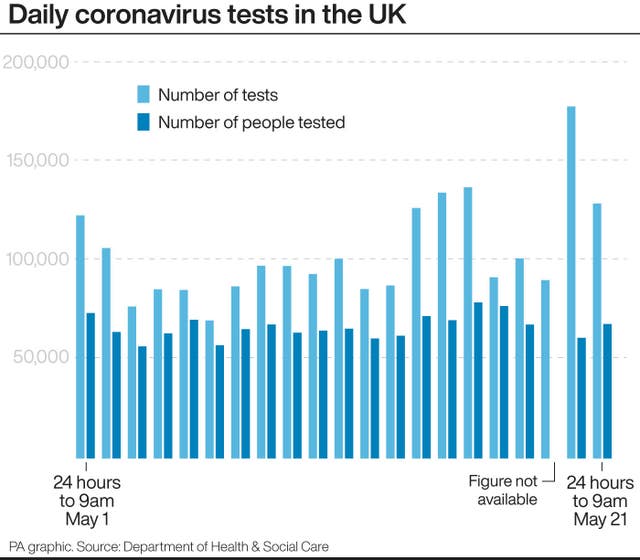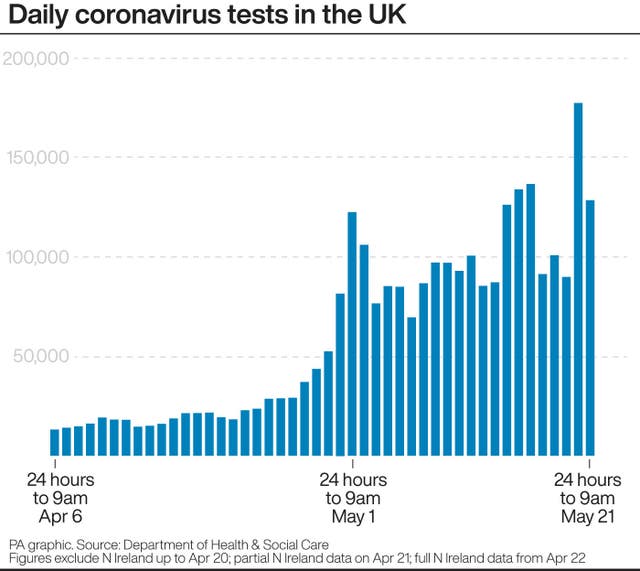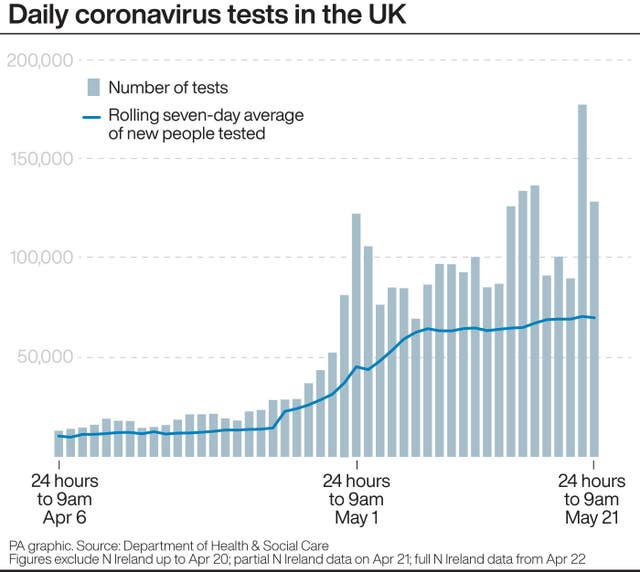What do the latest statistics tell us about testing for Covid-19?
How the numbers – and trends – have changed over the past month.

The number of Covid-19 tests taking place in the UK is one of the key announcements at the daily Downing Street press conference.
It has become a useful real-time measure of how the Government is faring in its effort to increase the amount of testing that is taking place across the country.
But what exactly does the number mean – and what do the latest statistics tell us about the overall trends in testing?
There are actually two numbers announced each day for testing: one is for the number of tests, and one is for the number of people tested.
Both numbers are for the 24 hours up to 9am on the day they are announced.
So the number of tests announced on Thursday, 128,340, covers the 24-hour period up to 9am on Thursday.
Similarly the number of people tested that was announced on Thursday, 67,681, was for the 24 hours up to 9am that day.
There is quite a big difference between these two numbers – but this is not unusual.

The number of tests is always higher than the number of people tested, because some people are tested more than once.
Just how much higher varies from day to day, however.
It can be almost twice as high – for example the figures for the 24 hours to 9am May 15, when the number of people tested was 69,590 while the number of tests was 133,784.
The scale of the difference between the number of tests, and the number of people tested, is further illustrated when comparing the total number of tests since the outbreak began – 3.09 million – with the total number of people tested – 2.06 million.
The total number of tests is 50% higher than the total number of people tested.
It is worth remembering that the number of tests does not refer solely to tests that have been completed, however.
Rather it is a combined total of tests processed through laboratories by the NHS, Public Health England and the devolved administrations, tests at drive-through sites and other locations, plus tests sent to individuals at home or to satellite testing locations.
For example, of those 128,340 tests announced for the 24 hours to 9am on Thursday, 66,224 were under “pillar 2” of the testing programme – swab testing for essential workers and their households. And while 25,125 of this 66,224 were tests processed in person, the rest, 41,099, were tests that were sent out.
This helps to explain why the number of tests jumps around from day to day, with logistical and distribution factors often playing a part in how high or low the total turns out to be.

Since the number of tests per day started to be published on April 6, there have been nine occasions when the number has been above 100,000: in the 24 hours to 9am May 1, May 2, May 11, May 14, May 15, May 16, May 18, May 20 and May 21.
However despite the fluctuations, since April 29 the number has always been above 50,000, and since May 7 it has always been above 80,000, suggesting that the overall long-term trend is upwards.
By contrast the number of people tested per day has never been above 100,000.
The closest so far was the 24 hours to 9am May 16, when 78,537 people were tested.
This particular number also has a tendency to jump around, but a rolling seven-day average of people tested per day shows that the overall trend has been moving slowly but steadily upwards, from around 12,000 in mid-April to 30,000 at the end of April, then passing 60,000 in early May.

Another trend that the daily figures do not reveal is the change in the number of positive cases of Covid-19 as a proportion of people tested.
Back in mid-April, this figure was around 32% – implying that roughly one in three people tested were testing positive.
But as the number of people eligible for testing has increased, this figure has drifted steadily downwards.
For example, as of 9am on May 1 a total of 762,279 people had been tested, and there had been 177,454 positive cases – the equivalent of just under a quarter (23%) of people testing positive.
The very latest figures, up to 9am on May 21, show that 2,064,329 people have been tested, and there have been 250,908 positive cases.
This is the equivalent of 12% of people testing positive.
This figure should continue to fall as more and more people are tested, and – depending on how many people are ultimately tested – could help give a sense of the overall infection rate for the whole country.





